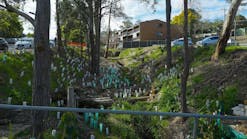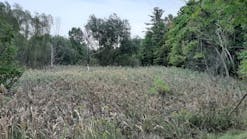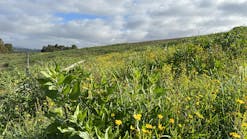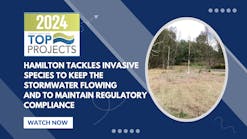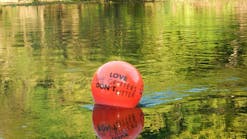When it comes to effective erosion control, landscape architects, agronomics professionals, and other vegetation experts must make a number of critical decisions early in the process to help ensure satisfactory results. Choosing the right vegetation to establish on a specific site and selecting the best application method are two important considerations on each and every project.For Derek Smith, these choices are complicated by a number of factors that he must address. Smith, who is based in Raleigh, NC, is the Vegetation Management Section engineer for the North Carolina Department of Transportation (NCDOT) and works cooperatively with other vegetation managers across the state. With 78,000 mi of rights of way on North Carolina’s interstate highways and primary and secondary roads, NCDOT has a lot of land to maintain and has more miles of rights of way than any other state in the country, except Texas, which only recently surpassed North Carolina in this area.“Here in the Southeast, we are in what we call ‘the transition zone,’ because, from an agronomic perspective, we could use either warm season grasses such as Bermudas or cool season grasses such as tall fescues,” explains Smith. “Although we could use both, neither will do as well as they do in other states, so operationally, we have divided the state into 14 regions, called divisions.”The seeding mix for each division varies depending on climatic and other conditions, such as proximity to the coast or mountains. Predominantly warm-season grasses are used in the four most eastern divisions, while mainly cool-season grasses are used in the four western divisions. In the six central divisions, a combination of the two is generally specified.“Typically, we have a standard seed mix in each of the divisions, and that seed mix is planted year-round, with the exception of some cover crops,” notes Smith. “In most cases, we are establishing turf grass, and on most projects, the seeding rates are calculated through research work we have done with North Carolina State University and from knowledge we have gained on past projects. It is like having a template to work with for each division.”In addition to the turf grasses, NCDOT is also using some native grasses on roadside projects, where they have more ornamental value and provide wildlife habitat. “We have found that the native grasses provide a dynamic fit in our wetland mitigation and stream restoration work,” says Smith. “When it comes to deciding when to specify native grasses, the DOT has its own biologists on staff, and we work closely with other state departments or agencies that have expertise in this area, such as the Department of Agriculture, the Department of Environment and Natural Resources, and the Wildlife Commission.”
Hydroseeding along Highway 18 in California for a Caltrans project after the fall 2003 firesBarona Creek Golf Club, in the San Diego foothills, where hydroseeding and fiber logs were successfully used in revegetation effortsSmith notes that native grasses are used in areas that don’t require mowing, allowing them to grow and flower, which provides a source of food and shelter for quail and other wildlife that use those rights of way. Turf grass is generally specified for areas that require regular mowing, which can be up to three times per year. “When we establish turf, it is what we refer to as “utility turf,” because we are looking for a product that requires minimal maintenance,” says Smith. “They may put a tall fescue on a golf course where a high-end turf is required, but it will also require frequent maintenance. A homeowner may go one step down from this, and might mow their lawn once a week or once every two weeks. With utility turf, we are putting the turf down to hold the soil in place so that it doesn’t wash away. The soil has been compacted when the structure or roadway was built, and establishing turf is what we need to do to stabilize the soil. We have to use a seed that germinates well, is adaptable to roadside conditions, and can survive without irrigation.”When it comes to planting methods used by NCDOT, Smith says 98% of the turf grass established is broadcast seeded, hydroseeded, or drill seeded. The balance is established through the use of sod, which is used only where aesthetics are important, such as in rest areas and welcome areas around the state. To establish native grasses, NCDOT generally uses either plugs or seeds.“For turf grass, how we seed depends on the slope, the soil type, and the agronomic parameters that we have to work within,” explains Smith. “The predominant thing we are interested in when seeding is getting good seed-soil contact. If you don’t get this, the seed will germinate, but it will dry out and die. The method of seeding is going to be different every time, depending on the site and what is best for that particular application.”Another planting method that Smith and NCDOT are looking at experimentally is blower spreading, which involves blowing mulch from an 18-wheel semi. Some of these trucks are equipped with a sliding axle, which allows them to operate in all kinds of terrain, but the big advantage to this system is the size of the vehicles. In addition to carrying a large payload of material, they can also carry up to 450 ft of hose or tubing, which helps the operator reach hard-to-access areas such as steep embankments.On the other side of the country, Mike Ritenour of Escondido, CA – based Hydrosprout Inc. is also making good use of long hoses, but in his case, they are being used with traditional hydroseeding trucks. Hydrosprout has a fleet of seven trucks, five of which are capable of pumping materials 1,500 ft uphill. Having this capability has been very beneficial recently because the company is one of several in southern California that have been called upon by the California Department of Transportation (Caltrans) to complete roadside work that needed to be done after last fall’s wildfires ravaged some areas of the region. In addition, Hydrosprout is also working for the County of San Diego to do similar work resulting from the wildfire damage. The two projects range from the recreation playground of Big Bear in the state’s San Bernardino Mountains to San Diego.Establishing vegetation on slopes presents special challenges.Sparsely vegetated slopes are especially prone to rill erosion.“Because of the different types of terrain throughout these areas, we have faced some challenges, but in one area for San Diego County we had to run hoses 1,500 feet up a hillside,” explains Ritenour. “This was a very steep slope; it was critical to achieve effective erosion control in order to protect the highway at the bottom of the hill and the homes located directly across the highway. Protecting homes, highways, and watersheds was treated as a high priority on both of these projects.”Ritenour adds that there were several reasons hydroseeding was selected as the primary way to re-establish vegetation on these slopes and other burn-damaged spots, but two of the main reasons were cost and the ability to selectively target specific areas.“Hydroseeding was the best bet all around. The number one reason was that it is the least expensive controllable method of covering large areas, but they were also able to tell us very specifically where to spray and where not to spray.”Ritenour has been monitoring the results to date, and so far he says everything seems to be working very well. “We did a lot of the installation work in January of this year, and since these areas are non-irrigated, the rainfall dictates how good the results will be. This means the timing is very important to the project’s success. We did have some light rain around the middle of February, which helped with germination, and then we had some heavy rain in late February, but because the seed had already germinated, it held well. Most of our clients are required to provide temporary erosion control until a minimum of 70% vegetative coverage is reached.”On both the Caltrans and San Diego County work, Hydrosprout was supplied with the seed mix and the mulch specifications. In the case of Caltrans, an on-staff biologist and the organization’s erosion control team determined what the best methodology was for each situation. With the work for the county, Hydrosprout worked closely with GeoSyntec Consultants in San Diego, a geotechnical firm that was contracted by both the City and County of San Diego to assess post-fire hazards and develop, implement, and manage restoration plans. Carol L. Forrest, P.E., CPESC/CPSWQ, and former president of IECA, was the overall project manager for the remediation effort. “The team decided to go with all native plants for the county work,” explains Mike Harding, CPESC, who acted as field operations manager for GeoSyntec and is also director of the Soil Erosion Research Laboratory at San Diego State University’s Department of Civil and Environmental Engineering. “We chose native seed mixes because they would not be invasive or compete with natural regeneration. We had the opportunity to be environmentally and technically correct, so we said, ‘Why not?'”For seed selection, Forrest and GeoSyntec enlisted the help of Julie Etra of Western Botanical. Etra is a botanist and is also past president of the Western Chapter of IECA, which covers California, Arizona, Nevada, and Hawaii. Once the seed selection was made and hydroseeding was determined to be the best method of application, the team decided to use two different methods: a bonded fiber matrix (BFM) and a hydraulic matrix composed of wood fiber and a guar-type tackifier. Harding notes that the BFM and the specific combination of wood fiber and guar that made up the hydraulic matrix had previously been tested successfully at the San Diego State University lab prior to starting the project.Many seed companies specialize in mixes native to a particular region.Hydroseeding in southern CaliforniaAccording to Harding, who can also add former president of IECA to his long list of credentials, what was planted and how it was planted was an important aspect of this project, but the real story was the teamwork that was prevalent on the job.“It starts with the assessment phase,” Harding says. “Few people can really appreciate how difficult it is to work under the constraints of time, pressure, and funding issues that follow a major disaster like a wildfire. Unless you’ve been in the crucible of that planning, you’d have no idea of the effort it takes to get that first gallon of mulch or that first gravel bag on the ground. It seems that everyone has an opinion on the science and technology that should be employed to control erosion and sedimentation, but the real art in this business is working within the regulatory, manpower, budgetary, and time constraints to get the job done quickly and correctly. Sure, green hydraulic mulch, straw wattles, and check dams are the visible part of the iceberg; the greater part of the effort lies in the process, and for that there are just too many engineers and resource scientists at the city, the county, and GeoSyntec to thank. Acknowledging Cid Tesoro and his stormwater group at the county, Lisa Adams and her crew at the city, and Carol’s engineering group at GeoSyntec would be a good start.“We had 400,000-plus acres to deal with,” Harding continues, “and there was a great cooperative effort by everyone involved, and this includes city and county employees who added this hazard-remediation work to their existing workload in stormwater pollution control. Both the City and County of San Diego hired the California Conservation Corps, who were responsible for installing the sediment control and runoff diversion structures. We worked very closely with the Natural Resources Conservation Service office in Escondido, specifically, Tom Benson and Jason Smith, in the development of the highest priority sites for treatment. Chuck Austin and his son David were brought in from Longmont, CO, specifically to coordinate and schedule all the hydraulic applications. It was just a great all-around effort by the County, the City, the engineering team at GeoSyntec, materials suppliers, contractors, and everyone else involved.”With larger jobs or extensive government contracts, many times the companies handling the application have the luxury of working with in-house or external seed experts, as was the case on the Caltrans and the San Diego County projects. But for smaller projects, the company doing the work, or the end client, may have to come up with its own solutions. S&S Seeds, based in Carpinteria, CA, can sometimes help in such situations. In the seed business for more than 30 years, the company specializes in seeds that are native to southern California. Four staff people prepare seed prescriptions to meet specific criteria on projects in the region.“We probably get four or five requests a day for custom seed mix designs, depending on the season,” explains Bruce Berlin of S&S. “Typically, we are fielding requests from repeat customers that we have built an extensive relationship with, including agency people like city planners and parks planners, engineering firms, and many landscape architects who are ultimately working for builders and developers. We ask a series of questions related to seed mix design criteria, or our clients can fill in a form on our Web site. When you have disturbed ground, erosion control typically comes up once we start asking the questions.”Berlin, who has a degree in environmental horticulture from California Polytechnic State University in San Luis Obispo, says the company finds that in most cases, “there is not a one-size-fits-all solution” to finding the right seed mix for a project. “Just here in southern California, we have all of the different geographic regions, from shoreline to desert to high elevation. Once we have the specific site information, it really doesn’t take a lot of extra effort to come up with the right custom-fit seed mix.”An important consideration for the people preparing the prescriptions is whether the vegetation project is temporary or permanent. With temporary projects, they lean toward annual plants that do not persist, but on jobs requiring permanent vegetation, they will often use perennials. Berlin adds that selecting the right seed mix is a science, but there is also an art to the process.“It is really a balancing act. You can specify something like a rye grass that will come up quickly, but you might be sacrificing longevity by doing this. In areas that are permanent, we tend to lean toward a mix of annuals and perennials because this can give you good coverage early on due to the annuals, but they will yield to the perennials after the first year. This is the art of it because if you are not careful, you can actually have your annuals outcompete your perennials in the first year for light and water.”Berlin says much of the staff’s knowledge about seed mix designs comes from the years of experience they have in not only collecting native seeds but also producing and growing their own seeds.“We can take what we know about seedling vigor, plant aggressiveness, seed counts, and so on and formulate a well-balanced, dependable seed mix.”In addition, Berlin says that when determining what mix is best for the site, they are always looking at the environmental impact of the job. “Depending on the project, you might be up against a riparian zone or a green belt, and here in California, if you are working in an ecological reserve, you have to be careful about using a plant that might escape. If we are up against a sensitive site, we need to know that so that we can use a native plant balance.”Center pivot irrigation helps control wind erosion in an eastern Washington fruit tree nursery.For Pat Teague of Lake Creek Seed in Worley, ID, the environmental aspect of any job he works on is what gets him the most excited. In late 2002, Teague used a combination of StrawNet pelletized straw mulch, hydroseeding, and to a lesser extent, coir mat, on a golf course project for the Couer d’Alene, ID, Native American tribe. In total, the project covers approximately 400 ac with about 7,200 yd of mat used. The course, which was voted by Golf Magazine as one of the 10 best new courses in the United States, is in the process of applying for membership in the Audubon Cooperative Sanctuary System (ACSS). Membership in ACSS has grown to over 2,300 courses worldwide since the program was implemented in 1991, and recognizes environmental excellence.Teague used the StrawNet product, which was supplied by the Wilbur-Ellis Company in Spokane, WA, for the fairways and areas of native plants, and used hydroseeding for the wetlands and riparian areas. The mat was used for some of the waterways. Seed selection for the fairways and rough areas was determined by the course owners with the help of an independent consultant, while Teague was responsible for selecting the seed in the wetlands areas.“I based my plant selections on past experience that I had gained on other projects,” notes Teague. “This includes reclamation projects and projects where I worked closely with the tribal fish and game people. We looked at plant survivability and how these plants would fit in the different environments. The Couer d’Alene Tribe is very committed to making this golf course an environmentally friendly place to be. We wanted to do things like enhance wildlife habitat and grow native medicinal herbs on the site. As for wildlife habitat, we wanted to select plants that would encourage quail, pheasants, geese, and ducks, while discouraging the deer, elk, and moose. One of the unique things we did on this project was to establish an interpretive area for young Native Americans to learn about their history and culture through native plants, such as the natural herbs.”Teague estimates that the StrawNet was used on approximately 60 ac of the project, including the entire driving range, which covers about 25 ac. He used hydroseeding in the wetlands because of difficulty accessing these areas. “I have to say that it is one of the better products that I have put down. On the fairways, we used a brillon seeder and then distributed the StrawNet with a top dresser, which provided us with a delivery system that was very accurate in terms of getting the right amount of straw per acre. One of the things that really impressed me with the StrawNet was the results we achieved considering how late in the year we started planting on this project. It was almost the end of October, which is far later than we should be planting in the Northwest, and we still achieved excellent results.”A polymer included in the StrawNet provides a protective cover for the plants while creating a moisture trapping layer. This layer prevents moisture from evaporating while enhancing seed germination and protects the seed and soil from erosion.Last summer, Teague went back to the course and worked as a horticultural and spray technician and was pleased to see the fruits of his labor paying off. “Everything is coming together very well,” adds Teague. “The Coeur d’Alene Tribe really cares about this project, and they did what was required to do things right the first time. I am very pleased to have been involved with this project, and I have to congratulate the tribe for their commitment to excellence.”Not too far away in Connell, WA, which is southwest of Spokane, Phil Rathbun has some interesting challenges every year in preventing soil erosion due to wind. Rathbun is a nursery manager for Montana-based Lawyer Nursery Inc. at the company’s Connell satellite operation. The Connell nursery grows over 250 different plant types, but specializes in fruit tree seedlings such as apple, pear, and cherry.“Here in eastern Washington, we know we are going to have wind in the spring; it is just a matter of how much,” says Rathbun. “We don’t want to let that wind start cutting our crop, so we are very careful with spring cultivation and tilling work. Our soil is very light and sandy, so we need to leave a rough surface and make dirt clods. If it looks nice and pretty, it will probably blow away.”In addition to leaving a rough surface, the nursery crews often plant winter wheat or rye between the rows of seedlings as another method of preventing wind erosion.“For our fruit trees, we are planting from seed in the fall,” explains Rathbun. “The seeds sit over the winter and then germinate in the late winter or early spring. At that point, they are very fragile and can blow away. The rows are just 14 inches apart, so we go through a month before we plant the seedlings and plant winter wheat or rye. This grows to about 3 inches over the winter, and then in the spring, we will let it grow to 5 or 6 inches and then we spray it out with a selective herbicide. By that point, there is enough of a skeleton on the seedlings that they can survive. We leave the dried wheat and rye carcasses in place for some added protection. A few weeks later, when the seedlings are at about 6 inches, we are able to use our overhead center pivot irrigation system to control wind erosion because the canal that feeds our water system opens in late March or early April.”To ensure that the wheat and rye do not interfere with the seedlings’ roots, Rathbun says they use a special seed drill that places the erosion control crop in just the right place. The nursery also tries to plant the seedlings in a direction that is angled to the wind in order to provide extra protection.“Our winds generally come from the southwest, so we try to plant our rows straight north and south so that it creates an angle,” adds Rathbun.For any challenging situation or scenario, there are normally a number of effective and innovative solutions, but with erosion control, the solutions will most likely be different in every case. It is a matter of planning the right seed mix, finding the best method of application, and relying on past knowledge and experience.
